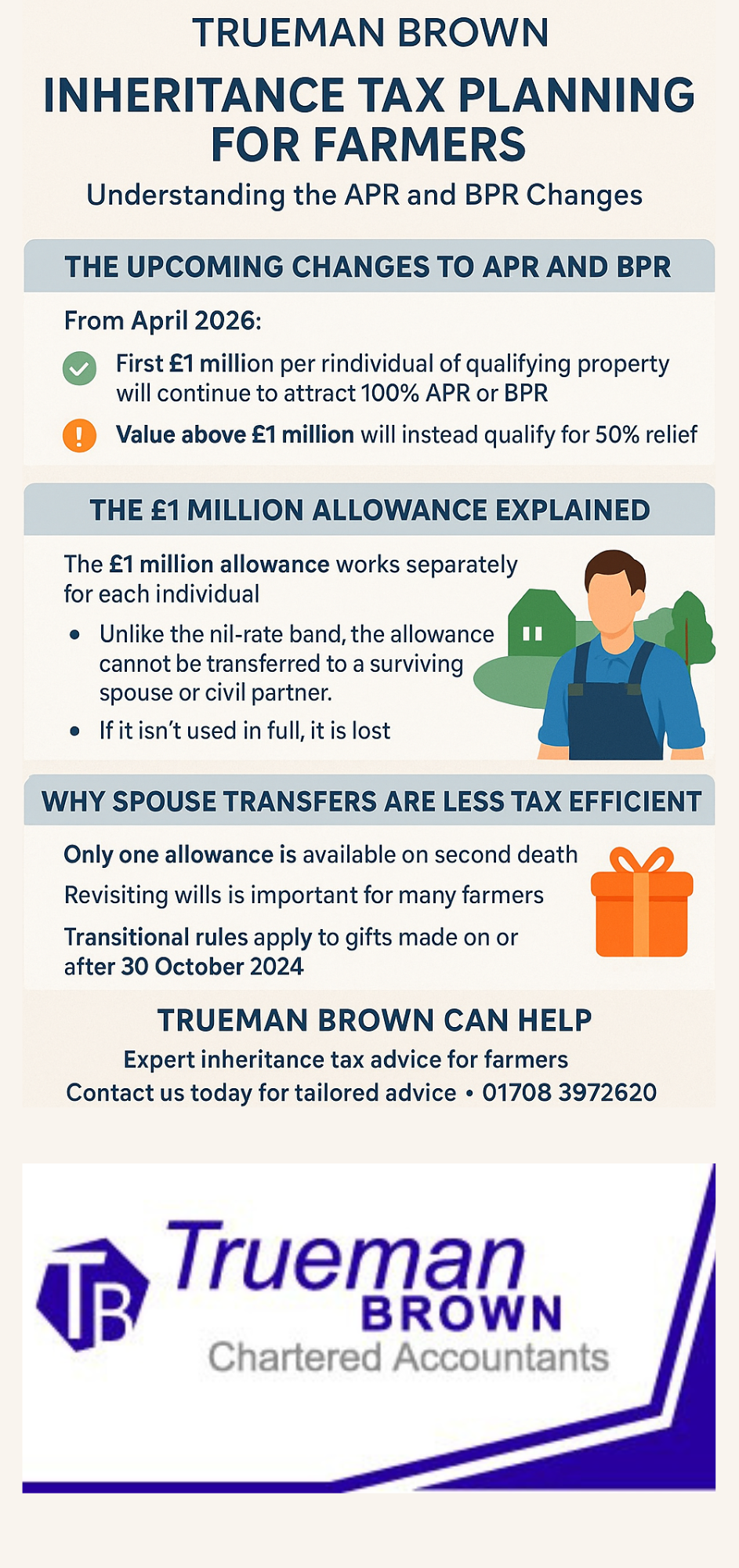Inheritance Tax Planning for Farmers – Understanding the APR and BPR Changes
Inheritance tax planning for farmers is about to become much more complex, particularly with the changes to Agricultural Property Relief (APR) and Business Property Relief (BPR) taking effect from 6 April 2026.
These adjustments mean that the generous 100% relief currently available on qualifying assets will be capped, and inheritance tax advice for farmers is essential for farming families wanting to protect their legacy.
The Upcoming Changes to APR and BPR Explained
At present, there is no limit on the amount of qualifying agricultural or business property that benefits from 100% relief. From April 2026, however:
-
The first £1 million per individual of qualifying property will continue to attract 100% APR or BPR.
-
The value above £1 million will instead qualify for 50% relief.
This new limit makes inheritance tax planning for farmers more urgent, particularly when passing on farmhouses, agricultural land, and farm businesses.

The £1 Million Allowance Explained
The £1 million allowance works separately for each individual.
Unlike the nil-rate band or the residence nil-rate band, any unused portion cannot be transferred to a surviving spouse or civil partner.
If it isn’t used in full, it is lost.
For farming families, this creates a major shift in how assets should be structured under wills and succession plans.
Inheritance tax planning for farmers will need to ensure the allowance is maximised for both partners.
Why Spouse Transfers Are Less Tax Efficient
Traditionally, farming couples left everything to each other on first death, relying on the spouse exemption.
While this still avoids inheritance tax initially, it wastes one £1 million allowance.
On second death, only one allowance remains, which means agricultural and business property above that limit only benefits from 50% relief.
By contrast, leaving £1 million of qualifying property directly to children or grandchildren on the first death ensures both allowances are preserved.
That way, the couple can secure 100% APR and BPR on £2 million of assets combined. This shift makes inheritance tax planning for farmers critical.
Considering Lifetime Transfers
Lifetime transfers remain an option for those wanting to pass on farmland or business assets early.
Such gifts are Potentially Exempt Transfers (PETs) and fall out of the estate if the donor survives seven years.
If death occurs within that period, inheritance tax applies, but taper relief may reduce the bill after three years.
However, transitional rules apply to gifts made on or after 30 October 2024 where the donor dies on or after 6 April 2026 within seven years of the gift.
In such cases, the £1 million cap still applies, which can reduce relief on later death.
For this reason, inheritance tax planning for farmers should consider the timing of transfers carefully.
How Trueman Brown Can Help
The changes to APR and BPR mean farming families should act now.
At Trueman Brown, we specialise in inheritance tax planning for farmers, helping clients restructure their wills, manage lifetime transfers, and maximise reliefs before and after the new rules come into force.
If you would like tailored advice on how these changes will impact your farm, please contact us:
📧 mark@truemanbrown.co.uk
📞 01708 3972620
We’ll guide you through the complexities and ensure your succession planning makes the most of available allowances.
FAQs – Inheritance Tax Planning for Farmers
1. Why is inheritance tax planning for farmers becoming more important from 2026?
Because APR and BPR will be capped at £1 million per person for 100% relief. Any qualifying assets above that value will only receive 50% relief, potentially creating significant tax liabilities for larger farms.
2. Can a surviving spouse use the unused £1 million allowance?
No. Unlike the nil-rate band, the £1 million APR/BPR allowance cannot be transferred between spouses or civil partners. If it isn’t used on first death, it is lost.
3. How can farmers make the most of their £1 million allowance?
Inheritance tax planning for farmers often involves restructuring wills to ensure that each spouse’s allowance is fully used — for example, by leaving qualifying assets directly to children or grandchildren rather than passing everything to the surviving spouse.
4. Do lifetime transfers still qualify for APR and BPR relief?
Yes, but transitional rules apply. If a gift is made after 30 October 2024 and the donor dies after 6 April 2026 within seven years, the £1 million cap applies. Careful timing is key in inheritance tax planning for farmers.
5. What steps should farmers take now?
Seek professional advice to review wills, consider early lifetime transfers, and plan how to allocate APR and BPR allowances effectively. Acting before April 2026 could save significant tax.
Final Thoughts
From April 2026, the landscape of inheritance tax relief for farming businesses changes dramatically.
With the new £1 million allowance and the reduced 50% rate above that threshold, inheritance tax planning for farmers is more important than ever.
Reviewing wills, considering lifetime transfers, and making use of both spouses’ allowances will help protect your farming legacy for the next generation.

Recent Comments